Acoustic guitar action refers to the height of the strings above the fretboard. It is also used to describe the general feel and playability of a guitar. Generally a guitar’s string height is measured at the 12th fret. This center measurement gives a good point of reference to tell how high the strings actually are. Action is also measured at the first fret. I’m sure you have heard people comment on guitars with “high action.” This just means that the strings are too high off the fretboard. Obviously, “low action” would mean the opposite.
Now that we know what action is, why is it important? Action is probably the most important part of any guitar setup. Proper acoustic guitar action not only controls the comfort and playability of the guitar, but it also helps the guitar stay in tune and maintain intonation. Acoustic guitar action is a little different than electric guitar action in that acoustic guitar strings need more room to vibrate. Think about it like this. When you play an electric guitar, you don’t really need to strum that hard in order to get a loud sound–acoustic guitars do. Also, acoustic guitar strings are much thicker than electric strings. Acoustic guitars need a higher action than electric guitars to prevent the strings from buzzing. Generally, the higher the action on a guitar, the more difficult and uncomfortable the guitar is to play and the lower the action, the easier and more comfortable the guitar is to play. Usually an action setup is a compromise between having the strings high enough not to buzz on the frets and low enough for comfortable playability. If you picked up an expensive guitar in a music store and found that it was uncomfortable to play, it could be that the action is not properly set. The feel of this guitar has nothing to do with the price or even the quality of the guitar; it is probably just not setup correctly.
After reading all of this, you are probably wondering how high should your action be. The truth is that it depends on your playing style. Acoustic guitar action and volume are directly related. That is why classical guitar players have higher action than steel string guitar players. Before there were amplifiers, classical players had to project their sound, so people could hear them–thus higher action was required. Lower action allows guitarists to play faster and more comfortably without compromising the volume. Essentially, the action on your or anyone else’s guitar is pure preference. There is no right or wrong string height, to an extent. Most guitars come out of the factory with standard action settings that the manufacturer deems appropriate. Some of these setting are not always the most comfortable for individual players’ styles. I will show you how to set your action to an industry standard action setting. Beyond that, it is up to you to fine-tune the action on your guitar to fit your personal style.
Guitar Repair Tools To Lower Your Guitar Action
Contents
Here’s a list of guitar repair tools that you’ll need to lower the action on your acoustic guitar and make it play perfectly.
StewMac Basic Guitar Setup Kit
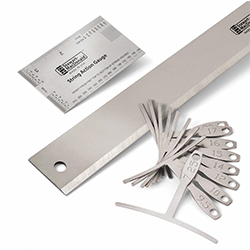 The StewMac guitar setup kit comes with a straight edge to check how straight the neck is when you are straightening the trussrod. It also comes with a set of gauges to measure both the string action height as well as the string and fretboard radius. If you want to do a complete setup on your guitar, this is the set to get.
The StewMac guitar setup kit comes with a straight edge to check how straight the neck is when you are straightening the trussrod. It also comes with a set of gauges to measure both the string action height as well as the string and fretboard radius. If you want to do a complete setup on your guitar, this is the set to get.
String Action Gauge Height Ruler
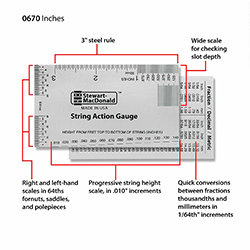 If you want to get an accurate setup with low, smooth action without any string buzzing, you have to get a string height ruler. This is the same rule that comes with the full set. It helps you measure your action, nut slot, and a bunch of other key measurements.
If you want to get an accurate setup with low, smooth action without any string buzzing, you have to get a string height ruler. This is the same rule that comes with the full set. It helps you measure your action, nut slot, and a bunch of other key measurements.
String and Fretboard Radius Gauge
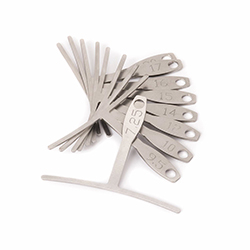 There is no way to get your strings lowered evenly without measuring the fretboard radius. You have to match your string radius with the fretboard to keep them all evenly above the frets. Here is another set the gauges that I use.
There is no way to get your strings lowered evenly without measuring the fretboard radius. You have to match your string radius with the fretboard to keep them all evenly above the frets. Here is another set the gauges that I use.
Truss Rod Wrenches
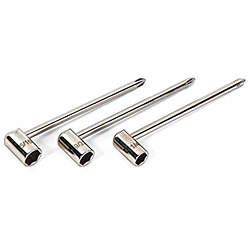
In order to properly lower the action on your guitar, you will need to make sure the neck is straight and the truss rod is adjusted. Here is a set of wrenches that will fit most guitar truss rod nuts, so you can easily adjust them no matter what guitar you have.
What causes High Action on a Guitar?
Before we start adjusting the action, it is important to know what causes the action to change and why it needs to be reset. Without knowing what is affecting your guitar, it is difficult to diagnose the problems and properly set the action. Here are several factors that contribute to poor or high action on your acoustic guitar.
Temperature and Humidity
As with all wood, guitars are affected by temperature and humidity. Acoustic guitars are especially affected by humidity changes. Drastic and rapid changes in either of these elements will change the shape of the wood. When the air gets humid, your guitar will soak up water in the air and the wood will expand or swell. The opposite is true about a lack of humidity. Drastic changes in temperature can do the same thing. Both temperature and humidity can cause your neck to bow or even warp. For an explanation of neck back-bow and relief, please visit the neck back-bow and relief page. For information about adjusting neck back-bow and relief, please visit the truss rod adjustment page.
String tension changes
Strings put a considerable amount of tension on the neck of the guitar. A lot of guitars are using altered tunings because of influences like Andy Mckee and Don Ross. Some of these altered and drop tunings don’t really sound right with light gauge strings, so guitarists switch to heavier gauge strings. Changing from a high to low or a low to high-tension string can cause back bow or relief in the neck. For an explanation of string tension, please visit the guitar string page.
Use and abuse
Obviously, guitars are meant to be played. Even if you don’t abuse your guitar, signs of wear will show up if you play it regularly. Eventually, heavy playing can wear down the nut and/or saddle pieces causing the problems with the action. These are both very common in acoustic guitars. Check out these articles for more information about nut and saddle adjustments.
How do I adjust the Action on my Acoustic Guitar?
Adjusting the action your acoustic guitar can be more than just turning an allen wrench. Depending on what is wrong with your guitar you may have to adjust it in a few different ways. In most cases, the cause or your high or low action on your acoustic guitar can be fixed with a simple truss rod adjustment. As long as you didn’t drop you guitar or do something to damage the neck or nut, the action adjustment should be fairly simple. Your action adjustment also depends on what type of guitar you have and the hardware on the guitar.
Generally, there are three steps the completely setting the action on your acoustic guitar. Don’t be fooled by some salesman at Guitar Center; in order to completely adjust the action on your electric guitar, you need to check and possibly adjust three different areas: truss rod, nut, and bridge. Your acoustic might play ok after you adjust the truss rod, but it probably won’t play as well as it could if you completely set the action in all three of these areas. These adjustments must be done in this order because one adjust will affect adjustments done after it.
Adjust the truss rod
![]() A guitar truss rod is a threaded, metal rod that is inlayed inside of your neck. The truss rod helps support the neck as well as keeps it straight. It can be tightened or loosened to straighten or flatten your neck. Not all acoustic guitars have truss rods. Martin guitars did not fully institute truss rods into their designs until the mid-1980’s. More likely than not, your poor action is because of your guitar neck’s straightness. Check your action and adjust the truss rod. If you adjust the truss rod and your action is set where you want it to be, there is no need to move on to the following two steps. Check out the truss rod adjustment page for step-by-step instructions on adjusting your truss rod.
A guitar truss rod is a threaded, metal rod that is inlayed inside of your neck. The truss rod helps support the neck as well as keeps it straight. It can be tightened or loosened to straighten or flatten your neck. Not all acoustic guitars have truss rods. Martin guitars did not fully institute truss rods into their designs until the mid-1980’s. More likely than not, your poor action is because of your guitar neck’s straightness. Check your action and adjust the truss rod. If you adjust the truss rod and your action is set where you want it to be, there is no need to move on to the following two steps. Check out the truss rod adjustment page for step-by-step instructions on adjusting your truss rod.
Adjust the action at the nut
![]() After you have adjusted the truss rod and your neck is straight, you can check the string height again with your ruler. Sometimes straightening the neck doesn’t solve the action problem, so you will have to check the action at the nut. In order to measure the action at the nut, you will need a set of feeler gauges . The action at the nut is measured at the first fret. A “standard” measurement of the distance between the bottom of the string and the top of the first fret is .060 inches. If the string is higher than .060 inches, you will need to file down the nut. For step-by-step instructions on filing down the nut, please see the how to lower the action at the nut on my acoustic guitar page.
After you have adjusted the truss rod and your neck is straight, you can check the string height again with your ruler. Sometimes straightening the neck doesn’t solve the action problem, so you will have to check the action at the nut. In order to measure the action at the nut, you will need a set of feeler gauges . The action at the nut is measured at the first fret. A “standard” measurement of the distance between the bottom of the string and the top of the first fret is .060 inches. If the string is higher than .060 inches, you will need to file down the nut. For step-by-step instructions on filing down the nut, please see the how to lower the action at the nut on my acoustic guitar page.
Adjust the action at the bridge
![]() The last step to a complete action adjustment on your acoustic guitar is to check and adjust the action at the bridge. Pretty much all acoustic guitars have a single saddle that spans the bridge. This saddle will have to be removed and adjusted. This sounds difficult, but it is quite simple guitar repair to do. Check out more detailed instructions on lowering the action on your acoustic guitar bridge on the acoustic guitar bridge adjustment page.
The last step to a complete action adjustment on your acoustic guitar is to check and adjust the action at the bridge. Pretty much all acoustic guitars have a single saddle that spans the bridge. This saddle will have to be removed and adjusted. This sounds difficult, but it is quite simple guitar repair to do. Check out more detailed instructions on lowering the action on your acoustic guitar bridge on the acoustic guitar bridge adjustment page.

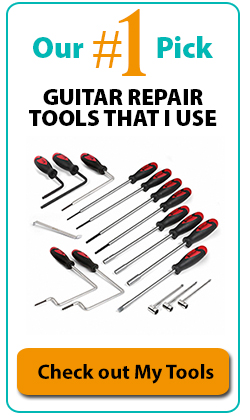
Very good instructions. I have not played my guitar for quite sometime but used to be in a semi-professional band in my youth. This information is very valuable. My 1969 Guild D50 guitar has excellent tone quality but the strings are a little high. When I had calluses, it was not an issue. But now that I lost my calluses, it matters more. It is important not to lose the tone but make it a little easier to play. That is why these instructions help a great deal.
Thanks for the help
this article has some good advice, but it mostly seems to be about selling products.
all a person needs to adjust the action is wrench that fits in the truss rod nut. it’s not a specialty tool – most people probably have one.
This isn’t really true, Dre. Adjusting the action is much more than just straightening the neck. In order to set your action accurately, you’ll need to adjust the bridge, nut, and neck. For these types of adjustments, you might need special tools.
Some standard tools (like nut drivers) don’t always fit in the truss rod pocket hole. Other tools (like standard allen wrenches) typically don’t reach inside the sound hole far enough to access the truss rod.
It all depends on your guitar. Either way, I think it’s worth having a special tool to do the job right and accurately set your guitar up to play great without hurting it.
No way !! — .060″ between the first fret and the string? More like .020″ or less. Also, everybody else recommends adjusting the bridge (saddle) before adjusting the Nut, not as the last step. — Misleading instructions !!
Hi Joyrider,
The reason you want to adjust the nut first is because it’s more sensitive and there is less room to remove material or screw up. A small nut adjustment affects the entire guitar significantly. Also, if you adjust the bridge first and then adjust the nut, your nut adjustment will throw off your prior bridge adjustment. Thus, you will have to adjust your bridge again. I don’t know who “everyone else” is, but they are doing it wrong. Haha.
You are free to setup your guitar any way you want, but this is a proven way to do it right the first time. Good luck with your setup. I hope you get your guitar playing great. Let me know if you have any questions along the way.
Cheers!